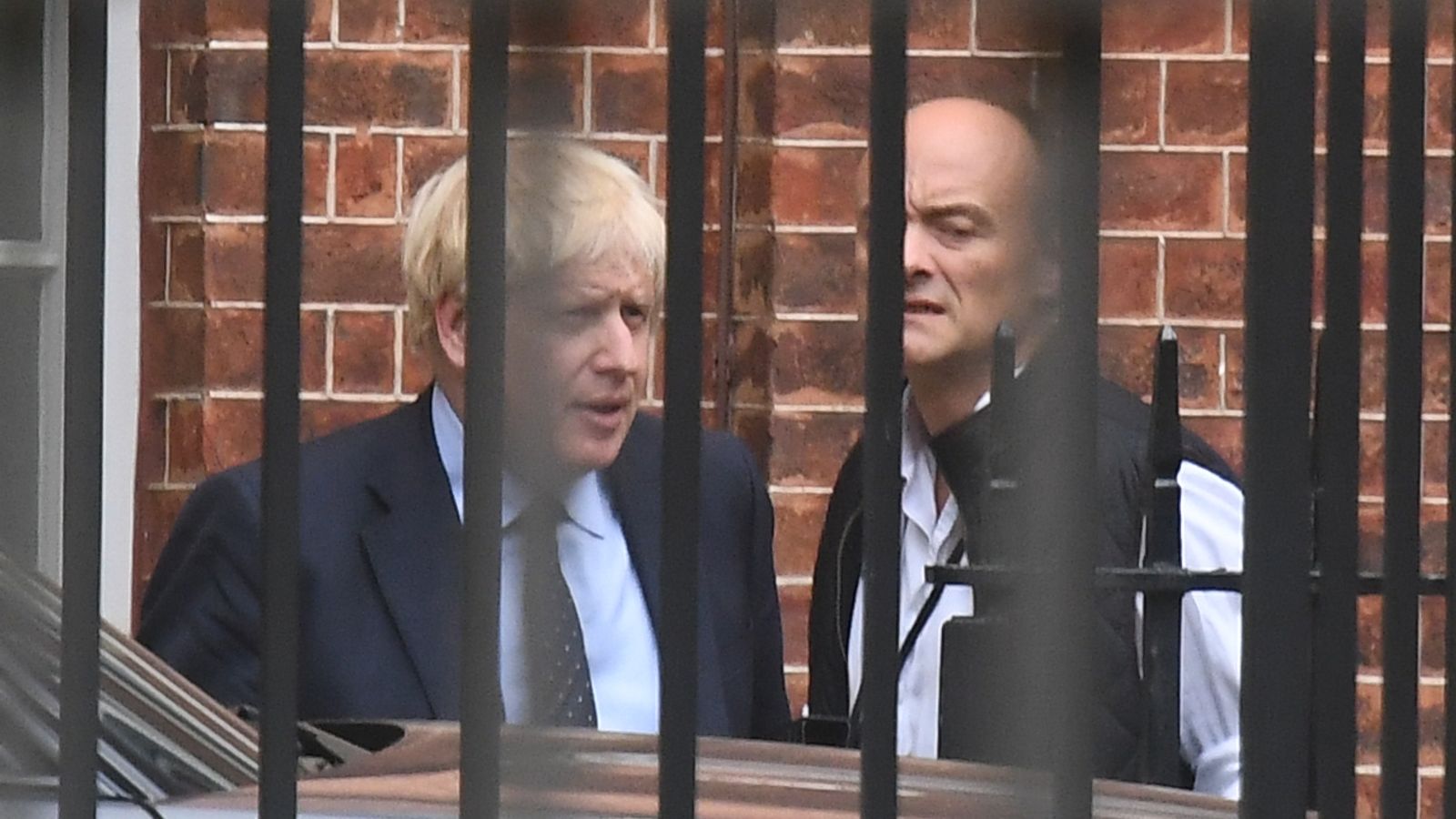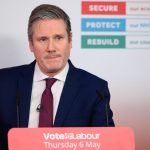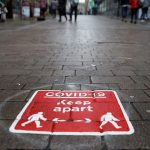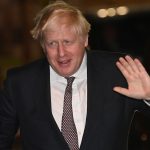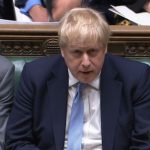During the early part of his evidence, Dominic Cummings laid out the events that led up to the first COVID lockdown on 23 March last year.
Follow live updates on Mr Cummings reporting to MPs
This is what he said happened in the weeks and months leading up to it:
First week in January
Conversations started to be had in Downing Street about the growing COVID outbreak in China. Mr Cummings said they would then “flair up” periodically in the days after that as stories about it appeared in the media.
First half of January
Mr Cummings, from his memory, said COVID was raised with the PM “because it was on the news”. “It was a general chat with me and other people”. During this time he also tried to get Downing Street to rearrange itself to be more effective but he “completely lost the argument”.
Second half of January
Mr Cummings said a lot of his time was spent working on procurement, but around this time he was also working on a data unit for No 10.
22 January
First meeting of SAGE (the government’s Scientific Advisory Group for Emergencies).
Early discussions at SAGE meetings after that were around whether to adopt the herd immunity approach – with concerns that a huge number of cases was inevitable, the choice was, 1. by doing nothing, there would be a high peak in the summer after which herd immunity would apply and the disease would fade away, or 2. suppress the virus in spring and summer but with the consequence that there would be a high peak in winter, after which herd immunity would apply.
The prevailing view, which formed over time, was that the former was better as there would be less disruption overall and to wait for the high peak to occur in winter would potentially cause more deaths. In the weeks afterwards, Mr Cummings said he attended some SAGE meetings, but not all. Instead he sent Ben Warner, a physicist he had appointed to help with a data unit he wanted to set up at No 10, who would report back to him with SAGE’s findings.
25 January
Mr Cummings said to the private office of No 10, he wanted to look at pandemic planning and wanted to go to Porton Down to talk to some people there about it. On the same day, he asked Health Secretary Matt Hancock: “Are we up to speed with pandemic planning?”
He said Mr Hancock outlined preparations, saying it was on the government’s “top tier risk register” and the preparations were being “stress tested”. Mr Cummings said at the hearing he regretted not following up on it and pushing it “the way that I should have done”.
First 10 days in February
Mr Cummings said that, in early February, less than half of his time was spent on COVID. In this period, he said there were other things going on – “the HS2 ‘nightmare’, the reshuffle on the 12th and then the PM went on holiday for two weeks”. He apologised to the hearing for not hitting the “panic button” during this period.
The PM’s former adviser said throughout February and early March his boss took the attitude that the “real danger” was the public’s reaction to COVID fears and the impact it would have on the economy.
Middle of February
Lots of key people were literally skiing during this period, Mr Cummings said. In February, Mr Cummings said that the PM regarded COVID as a “scare story – the new swine flu”.
Last week of February
Mr Cummings said there wasn’t any sense of urgency about COVID, from No 10 or the Cabinet Office.
First half of March
Much of the assumption about why herd immunity was thought the best approach was based on the belief that the British public would not tolerate a lockdown and an East Asian-style test and trace system.
During this time, Mr Cummings said this point of view was raised in the PM’s office but he and others were pointing to the TV and saying “look what’s happening in Lombardy (in Italy). This assumption that the public don’t want a lockdown is false and we should abandon it (the prevailing assumption)”.
5 March
Another SAGE meeting – five weeks after the World Health Organisation had said it was a public health emergency of international concern.
The minutes of the meeting say the only approach thought viable and necessary at that point was the need to shield the vulnerable, while the rest of the country should become infected to allow herd immunity to be achieved over time.
Mr Cummings said he didn’t advise the PM that the approach was wrong but by that point he was having “smart people” coming to him and telling him the US approach (of doing little to slow the outbreak) was wrong and the UK would have to lock down.
He said, despite that, the official view all the way through to the 16 March was that lockdowns were “more dangerous (than allowing the outbreak to run its course)”. At this point, Mr Cummings says the thinking was the UK would not close pubs, leisure, mass events etc.
7 March
Ben Warner’s brother Mark, who was building a data dashboard for COVID for the NHS, came to Mr Cummings and said he was worried about the plan that was being put in place to deal with the coming outbreak – which at that point involved allowing the virus to spread, so that herd immunity was achieved.
He told Mr Cummings: “It could be mad, could be incredibly destructive. Has it been tested and thought through?”
9 March
A key week, according to Mr Cummings. Because of the earlier SAGE discussions on herd immunity, officials were heard talking about it as a concept.
Mr Cummings said: “It wasn’t that it was thought of as being a good thing, it was a question of inevitably, of timing – that was the whole logic of all the discussions in January, February and early March, and that was why… people from SAGE and the government started to say publicly about herd immunity – you either have herd immunity by September, or by January, and that was the assumption up to Friday 13th”.
During this week, Mr Cummings said he got in contact with Professor Tim Gowers, a mathematician from Cambridge University and Demis Hassabis, an artificial intelligence expert and founder of DeepMind, and started sharing SAGE documents with them. He said they “could understand the technicalities”.
11 March
Some SAGE members said publicly “we are going to be shielding people and by the time we come out of it we are going to have herd immunity”. Mr Cummings says, at that time, “that was the plan” and he was completely baffled as to why No 10 has tried to deny that.
Night of 11 March
Mr Cummings texted the group that included the PM and Patrick Vallance, the chief scientific adviser, telling them that many experts were saying the risk of delaying the introduction of tougher restrictions was very high and the government would have to work much harder to publicly justify it, if they continued to delay bringing them in.
He said, at that point, most people in SAGE still felt the herd immunity approach was best and that was why he felt reluctant to tell the PM the prevailing scientific advice was wrong. He said part of the reason that was contributing to the prevailing view was that there was a “pushback” in the system for a delay because there was no plan in place.
12 March
A day that Mr Cummings describes as “completely surreal”.
At 7.48, he texted the PM, saying “we’ve got big problems coming. The Cabinet Office is terrifyingly s***. We must announce today, not next week, ‘if you feel ill, stay home’. We are looking at between 100,000 and 500,000 deaths.”
He said the day started to be about COVID but got derailed because the National Security team came and told the PM that Donald Trump wanted the UK to join a bombing campaign in the Middle East, so they started having meetings about that.
On the same day, Mr Cummings said the prime minister’s girlfriend had gone “completely crackers” about a Times story about her, the PM and their dog. She was “demanding” the press office deal with “something completely trivial”.
At the meeting on COVID later on, they decided to press on with household quarantine. Meanwhile, the attorney general persuaded the PM not to join the bombing campaign.
At the end of the day, Mr Cummings met with Ben Warner and his brother Mark and they impressed on him “we are heading for total catastrophe, we need plan B”.
13 March
Ben Warner went to speak about his fears to Patrick Vallance, who also expressed his worries. The graphs were showing that even with the official plan, which by that point included household quarantine, “you are going to completely smash through the capacity of the NHS”.
That evening, they decided they were going to have to sit down with the PM and tell him they would have to ditch the plan, and prepare for the “biggest disaster this country has seen since 1940”.
At that point, Mr Cummings said, the second most powerful official in the country, deputy Cabinet Secretary Helen McNamara, came up and said she’d been told by the official responsible for coordinating with the Department for Health that, despite having been told in the past there was a plan for a major pandemic, “there is no plan. We’re in huge trouble… we are absolutely f*****… we are going to kill thousands of people”.
14 March
Mr Cummings showed the PM the white board with “plan B”.
65/ First sketch of Plan B, PM study, Fri 13/3 eve – shown PM Sat 14/4: NB. Plan A 'our plan' breaks NHS,>4k p/day dead min.Plan B: lockdown, suppress, crash programs (tests/treatments/vaccines etc), escape 1st AND 2nd wave (squiggly line instead of 1 or 2 peaks)… details later pic.twitter.com/IRl0M3swSl
After the official meeting in No 10, Mr Cummings and Ben and Mark Warner had a private meeting with the PM and showed him the graphs which explained what was going to happen.
Mr Cummings said Ben Warner told the PM “we are going to have to lockdown, but there is no lockdown plan. SAGE haven’t modelled it. DH (Department of Health) don’t have a plan. We are going to have to figure out a lockdown plan”.
He said it was “like a scene from Independence Day with Jeff Goldblum saying the aliens are here and your plan is broken, you’re going to need a new plan, with Ben Warner in the Jeff Goldblum role”. He showed the PM the figures and told him the NHS was going to be “smashed” within weeks and he had “days” to act.
15 March
Mr Hancock said publicly “we have a plan and herd immunity is not part of it”, but Mr Cummings said that was wrong, as herd immunity had been part of the plan all along, up until that point.
16 March
The PM announced a change of approach and people were advised to stay at home. But pubs were not closed and mass events were not stopped. Mr Cummings explained that part of the reason for that was because there was no lockdown plan at that point.
Sometime after 12-13 April
In his early evidence, Mr Cummings also explained why he updated his blog. He said it was to restress his thoughts on pandemic planning, reiterating those he had expressed the year before. He said the reason why he did this was because he thought it was going to become a huge US election issue.
